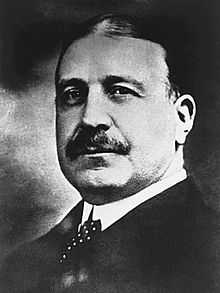Francis Clergue

Francis Hector Clergue (August 28, 1856 – January 19, 1939) was an American businessman who became the leading industrialist of Sault Ste. Marie, Ontario in Canada, at the turn of the 20th century.[1]
Born in Brewer, Maine, Clergue studied law at the University of Maine after which he was involved in a number of business ventures until coming to Ontario, Canada. Clergue came to the city backed by Philadelphia businessmen. He saw the potential for industry with the location of the town. He helped establish a hydro-electric dam which provided the town with cheap and abundant electricity. Following the 1895 construction of a new canal and lock, he founded paper mill St. Mary's Paper (closed in 2011),[2] Algoma Steel (now called Essar Steel), as well as a portion of the Algoma Central Railway connecting the city to the transcontinental artery of Canada, for which the city is most noted. He also established the Helen and Gertude mines. He used all of his ventures collectively to build his empire. Algoma Steel was started by using pig iron from the Helen mine to make steel rails. By 1903, Clergue had overextended himself and the companies that he had founded continued under new management.
He spent his latter years in Montreal, Quebec, in Canada where he died.
Popular Canadian author Alan Sullivan's novel The Rapids (1920) is inspired by Clergue's life. In 1946, Sir James Dunn, the then owner of Algoma Steel, commissioned Sullivan to write Clergue's biography. Provisionally titled Before the Tide, it has never been published.[3]
A Park and a French immersion Public School are named after Clergue. Clergue was inducted into Sault Ste. Marie's Walk of Fame in 2006.
References
- ↑ Woodbridge, Dwight E. (May 1902). "A New Centre of Vast Industry". The World's Work (New York, NY: Doubleday, Page & Co.,) II (1): 758–760. Retrieved April 29, 2012.
- ↑ http://www.sootoday.com/content/news/details.asp?c=54024
- ↑ Brian Busby. Character Parts: Who's Really Who in CanLit. Toronto: Knopf Canada, 2003. p. 57.
External links
|